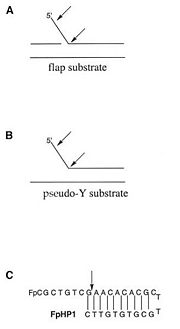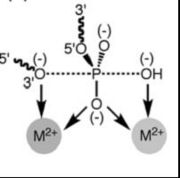Sand box 211
From Proteopedia
Contents |
Description
The T5 5'-exonuclease, also called T5 5'-3' exonuclease, is a member of the family of flap endonucleases (FEN), also known as 5'-nucleases, and is composed of 291 amino acids. Flap endonucleases are present in almost all living organisms. They participate in DNA replication, by removing the Okazaki fragments, and repair processes. In addition, they are able to cleave branched DNA by catalyzing the exonucleolytic hydrolysis of the phosphodiester bonds present in the DNA. Furthermore, they have an endonucleolytic activity which consists in cleaving DNA flap structures. Both activities are structure-specific because they only take place in presence of double strand-single strand junctions in bifurcated nucleic acid substrates like the flap (A on the figure on the left), the pseudo-Y (B on the figure on the left) and the 5'-overhanging hairpin (C on the figure on the left) substrates.The T5 5'-exonuclease is found in bacteriophages T5 and is coded by the gene D15. It is called metalloenzyme because it has binding sites for divalent metal ions without which the enzyme isn't able to cut DNA [1]. However, it can bind to DNA without binding a divalent metal ion.
Activity
The T5 5'-exonuclease is able to cleave 5'flap or « pseudo Y » structures, one nucleotide into the double-stranded region downstream of a single-stranded 5'arm. They have also an exonucleolytic activity on free 5' ends of single-stranded or double-stranded DNA. They hydrolize phosphate diester linkages between nucleic acids which requires at least two divalent metal ions independently bound to the enzyme. The exonucleolytic and endonucleolytic hydrolyses cleave the 3'-oxygen phosphorus bond generating products terminating in a 3'-hydroxyl group and a 5'-phosphate monoester.
During the DNA replication processes, the T5 5'-exonuclease plays an important role by removing RNA primers from the 5’ end of the Okazaki fragment. This allows the ligation between the Okazaki fragment and the 3’ end of upstream DNA fragment. Enzyme activity and DNA binding depends on the pH. At low pH, the association constant of the enzyme is maximal whereas the turnover number of the enzyme is maximal at high pH. It’s due to the protonation of Lys83, which is a catalytic residue in the active site.
Structure
|
is a homodimeric protein composed of two identical chains, and . Both chains contain a hole, bound by a composed of two helices in which are located. The helical arch is situated in front of the active site and only single-stranded DNA can pass through it[2]. Since the enzyme is able to cleave double-stranded DNA, the enzyme has a conformational flexibility to facilitate DNA threading which is required to process the 5' nuclease substrates in the active site.
The core regions of the enzyme are composed of and . These form the base of the active site pocket which bind the catalytic metal ions.
The active site possesses 8 conserved (Asp26, Asp68, Glu128, Asp130, Asp153, Asp155, Asp201, Asp204) which interact with divalent metal ions. is also a conserved residue located in the active site, but it doesn't seem to have an important role since its mutation doesn't dramatically change the affinity to bind DNA [3]. (Arg33, Lys83, Arg172, Lys196, Lys215, Arg216 and Lys241) near the active site permit binding to branched DNA. is positioned in the helical arch region close to metal site 1. It has an important binding role as well as a catalytic role [4]. It was shown that DNA binding is pH dependent which means that the T5 5'-exonuclease requires protonation of Lys83 to be able to bind to DNA. The mechanism of the Lys83 in the catalytic activity is still unknown, but it has been proposed that Lys83 acts as a general base/acid activating water to attack the scissile phosphodiester bond and protonating the leaving oxygen [5] [6]. is positioned between two metal sites. Its mutation perturbs metal ion binding[7]. are important for binding to the 5' overhanging hairpin substrate [8]. Furthermore, residues form part of a helix–loop–helix feature. binds to a phosphodiester residue in the 3'end of the cleavage site.
The reaction only takes place if at least two divalent metal ions are bound to the enzyme. However, the DNA binding doesn't need the presence of metal ions. Metal ions participate in the enzymatic catalysis of phosphodiester bond in several ways. For example, they can act as a nucleophile or a general base. They also participate in the catalysis of phosphate diester hydrolysis reactions by interacting with the oxygens which are not involved in the scissile phosphate (figure left).
Following divalent metal ions permit the reaction to take place : , Mg2+, Co2+, , Fe2+ and Cu2+. However, the reaction is the most efficient with Mn2+ and Mg2+ as cofactors. Furthermore, it has been shown that T5 5'-exonuclease is able to cleave double-stranded closed-circular plasmids with an Mn2+ cofactor although this enzyme normally is only able to cleave single-stranded 5' ends [9]. The two binding sites for metal ions are located near (Asp26, Asp68, Glu128, Asp130, Asp153, Asp155, Asp201 and Asp204) which are responsible for binding them [10]. However, previous studies have shown that the enzyme needs three metal ions for the reaction. As most of the T5 5'-exonuclease x-ray structures in the absence of substrate show only two divalent metal ions bound, it implies that the third metal ion binds only in the presence of substrate, to stabilize the enzyme-DNA complex, and has less affinity for the free enzyme. However, the reaction also takes place, if there are only two metal ions present which confirms the two-metal-ion mechanism (figure) and that only two metal ions are needed for the catalytic reaction [11]. The activity of the enzyme changes with the metal ion, which means that for example the T5 5’-exonuclease is more active with Mn2+ than Co2+ or Mg2+ because Mn2+ ions bind most strongly to the protein.
The T5 5'-exonuclease is inhibited in presence of Ca2+ ions. It is a competitive inhibition which means that the Ca2+ binds to the metal binding site and doesn't permit the binding of the catalytic divalent metal ion.
Applications
The T5 5’-exonuclease is used for plasmid and oligonucleotide mutagenesis. It can be used to destroy anything apart from pure closed circular plasmid, so it is useful to increase transfection efficiency and to reduce background in cloning experiments. T5 5’-exonuclease is also used to remove denatured DNA from alkaline-based plasmid purification for improved cloning procedures.
External Resources
References
- ↑ Tock MR, Frary E, Sayers JR, Grasby JA. Dynamic evidence for metal ion catalysis in the reaction mediated by a flap endonuclease. EMBO J. 2003 Mar 3;22(5):995-1004. PMID:12606565 doi:10.1093/emboj/cdg098
- ↑ Ceska TA, Sayers JR, Stier G, Suck D. A helical arch allowing single-stranded DNA to thread through T5 5'-exonuclease. Nature. 1996 Jul 4;382(6586):90-3. PMID:8657312 doi:10.1038/382090a0
- ↑ Patel D, Tock MR, Frary E, Feng M, Pickering TJ, Grasby JA, Sayers JR. A conserved tyrosine residue aids ternary complex formation, but not catalysis, in phage T5 flap endonuclease. J Mol Biol. 2002 Jul 26;320(5):1025-35. PMID:12126622
- ↑ Sengerova B, Tomlinson C, Atack JM, Williams R, Sayers JR, Williams NH, Grasby JA. Bronsted analysis and rate-limiting steps for the T5 flap endonuclease catalyzed hydrolysis of exonucleolytic substrates. Biochemistry. 2010 Sep 21;49(37):8085-93. PMID:20698567 doi:10.1021/bi100895j
- ↑ Pickering TJ, Garforth S, Sayers JR, Grasby JA. Variation in the steady state kinetic parameters of wild type and mutant T5 5'-3'-exonuclease with pH. Protonation of Lys-83 is critical for DNA binding. J Biol Chem. 1999 Jun 18;274(25):17711-7. PMID:10364212
- ↑ Pickering TJ, Garforth SJ, Thorpe SJ, Sayers JR, Grasby JA. A single cleavage assay for T5 5'-->3' exonuclease: determination of the catalytic parameters forwild-type and mutant proteins. Nucleic Acids Res. 1999 Feb 1;27(3):730-5. PMID:9889266
- ↑ Garforth SJ, Ceska TA, Suck D, Sayers JR. Mutagenesis of conserved lysine residues in bacteriophage T5 5'-3' exonuclease suggests separate mechanisms of endo-and exonucleolytic cleavage. Proc Natl Acad Sci U S A. 1999 Jan 5;96(1):38-43. PMID:9874768
- ↑ Dervan JJ, Feng M, Patel D, Grasby JA, Artymiuk PJ, Ceska TA, Sayers JR. Interactions of mutant and wild-type flap endonucleases with oligonucleotide substrates suggest an alternative model of DNA binding. Proc Natl Acad Sci U S A. 2002 Jun 25;99(13):8542-7. PMID:12084915 doi:10.1073/pnas.082241699
- ↑ Garforth SJ, Patel D, Feng M, Sayers JR. Unusually wide co-factor tolerance in a metalloenzyme; divalent metal ions modulate endo-exonuclease activity in T5 exonuclease. Nucleic Acids Res. 2001 Jul 1;29(13):2772-9. PMID:11433022
- ↑ Tomlinson CG, Syson K, Sengerova B, Atack JM, Sayers JR, Swanson L, Tainer JA, Williams NH, Grasby JA. Neutralizing mutations of carboxylates that bind metal 2 in T5 flap endonuclease result in an enzyme that still requires two metal ions. J Biol Chem. 2011 Sep 2;286(35):30878-87. Epub 2011 Jul 6. PMID:21734257 doi:10.1074/jbc.M111.230391
- ↑ Syson K, Tomlinson C, Chapados BR, Sayers JR, Tainer JA, Williams NH, Grasby JA. Three metal ions participate in the reaction catalyzed by T5 flap endonuclease. J Biol Chem. 2008 Oct 17;283(42):28741-6. Epub 2008 Aug 11. PMID:18697748 doi:10.1074/jbc.M801264200


